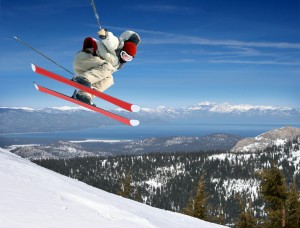 With the Winter Olympics coming up in a few days, we are all on the edge of our seats waiting to see the next best skiing legend, bob sledding champion or snowboard extraordinaire. For the next couple weeks, we can live vicariously through the winter athletes on our television. However, unless we are professionals ourselves, it may be in our best interest to “not try this at home”. If you do not know what you’re doing, winter sports can be extremely dangerous. Are they more dangerous than summer olympic sports? Looking at the speeds, heights and frigid temperatures for most of the events, the obvious answer is most likely, yes. Below is an article from about.com discussing the potential room for injury in winter sports. Basically, the moral of the article is unless you know what you’re doing or are under the supervision of an expert, stay off the luge track and go for a jog instead. Exercise is great, injuries … not so much.
With the Winter Olympics coming up in a few days, we are all on the edge of our seats waiting to see the next best skiing legend, bob sledding champion or snowboard extraordinaire. For the next couple weeks, we can live vicariously through the winter athletes on our television. However, unless we are professionals ourselves, it may be in our best interest to “not try this at home”. If you do not know what you’re doing, winter sports can be extremely dangerous. Are they more dangerous than summer olympic sports? Looking at the speeds, heights and frigid temperatures for most of the events, the obvious answer is most likely, yes. Below is an article from about.com discussing the potential room for injury in winter sports. Basically, the moral of the article is unless you know what you’re doing or are under the supervision of an expert, stay off the luge track and go for a jog instead. Exercise is great, injuries … not so much.
Thrills, Chills and Spills at the Winter Olympics
Are Winter Sports More Dangerous Than Summer Sports? – By Elizabeth Quinn
The Winter Olympics have a reputation for showcasing daredevil athletes careening across ice and snow with little regard for the powers of gravity. The spectacular crashes of downhill skiing appear to delight spectators as much as the grace and artistry of figure skating. In fact, aside from the stories about the big name star athletes in the Games, much of the news highlights during the Games will cover the most impressive crashes, falls and wipe-outs of the day.
Despite the added layers of protection, including required helmet use in ten of the fifteen Winter Olympic events, injury rates at the Games are relatively high, and many of those injuries are traumatic. While Summer Olympic athletes tend to suffer numerous sprains and muscle pulls, medical personnel at the Winter Olympics commonly treat fractures, lacerations, head injuries andtorn ligaments.
Why Are the Winter Olympic Sports So Dangerous?
The obvious answer is, perhaps, the high speeds at which winter athletes travel over snow and ice. Crashing on an iced track or into a protective barrier at 45 to 90 mph is going to result in an injury, or worse. Ahorrific luge crash on the eve of the 2010 Olympic Games caused the death of Georgian luger Nodar Kumaritashvili and turned all eyes on the risks these athletes face when technology, and athletes, are pushed to the limit.
Other winter sports are also full of injury risks. Strap razor-sharp blades on your feet, or make a slight miscalculation as you attempt to land on a snow-covered slope after flying 400 feet through the air, and it’s not hard to see the danger of the Winter Olympics. It’s also not hard to imagine that the injuries suffered by winter athletes are often more serious than the pulled muscles and sprained ankles that plague summer athletes.
Death-Defying Speeds and Heights at the Winter Olympics
- Luge – Competitors slide feet first down an icy tube on a small sled reaching 95 mph.
- Downhill skiing – A nail-biting free-fall down a mountain at 80 mph.
- Aerial ski jumping – Jumpers perform twists and somersaults 40 feet in the air.
- Ski jumping – Athletes soar 400 feet or more through the air and land on a snow-covered hill.
- Short track speed skating – Six skaters fly around a tiny oval shoulder to shoulder at 35 mph.
- Ski cross – Four skiers race each other on one course at up to 50 mph.
Ski cross, you say? What in the world is ski cross?
Yes, ski cross. Think NASCAR, or perhaps roller derby, on snow and you get the idea. Ski cross makes its Olympic debut in the 2010 Olympics and is likely to be a fan favorite. It’s fast and unpredictable with four skiers racing down a mountain negotiating a course of gates, moguls, jumps, turns and straightaways at nearly 50 mph.
Clearly, the Winter Olympics are for daredevils, and for those of us who like to watch athletes perform unimaginable feats from the safety of our sofas. And, I’ll admit, the thrills of those spills don’t hurt either.
Sources:
FIS – Injury Surveillance System (ISS) Data. International Ski Federation http://www.fis-ski.com/. Accessed February 12, 2010.
G Succo, et al. XX Olympic and IX Paralympic Winter Games: the ENT experience. Acta Otorhinolaryngol Ital. 2008 June; 28(3): 101–109.
